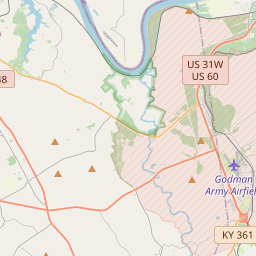County Named, 1823







© OpenStreetMap contributors
For Capt. James Meade, recognized for bravery and daring at Battle of Tippecanoe, 1811. Made captain in 17th US Infantry, March, 1812. Killed at River Raisin, Jan. 22, 1813, and one of nine officers at that battle for whom Kentucky counties named. Meade was formed out of parts of Breckinridge and Hardin counties, Dec. 17, 1823, by Act of Kentucky Assembly
Loading...
Searching for other points of interest within 3 miles of this location.The word "Kentucky" is derived from the Native American word "ken-tah-ten," which means "land of tomorrow."
About Meade County
Meade County Timeline
Meade County, Kentucky has a rich and storied history that dates back to its establishment in 1824. Named after Captain James M. Meade, a soldier in the Battle of Tippecanoe, the county was initially formed from parts of Hardin and Breckinridge counties. With its prime location along the Ohio River and proximity to Louisville, Meade County quickly became an important transportation hub in the region.
In the mid-19th century, Meade County experienced significant growth due to the flourishing steamboat industry. The Ohio River served as a major trade route, and the county's ports and landing sites became bustling centers of commerce. The arrival of the Louisville and Nashville Railroad in the 1880s further boosted the county's economy and allowed for easier transportation of goods and people.
During the Civil War, Meade County played a strategic role due to its geographical significance. Both Union and Confederate forces vied for control over the area, leading to several skirmishes and battles. Notably, the Battle of Brandenburg, fought in 1861, witnessed Union victory and marked a turning point in the war in Kentucky. Today, Meade County prides itself on preserving its Civil War history through various historical sites and monuments.
In the 20th and 21st centuries, Meade County continued to evolve economically and socially. The establishment of Fort Knox, a U.S. Army post, in 1918 brought military influence and economic stability to the county. Fort Knox remains an integral part of Meade County, providing jobs and supporting the local economy. Over the years, the county has seen increased investment in industries such as agriculture, manufacturing, and tourism.
Overall, Meade County's history is one of growth, resilience, and adaptation to changing times. Today, it continues to be a vibrant community that celebrates its past while embracing the opportunities of the future.
In the mid-19th century, Meade County experienced significant growth due to the flourishing steamboat industry. The Ohio River served as a major trade route, and the county's ports and landing sites became bustling centers of commerce. The arrival of the Louisville and Nashville Railroad in the 1880s further boosted the county's economy and allowed for easier transportation of goods and people.
During the Civil War, Meade County played a strategic role due to its geographical significance. Both Union and Confederate forces vied for control over the area, leading to several skirmishes and battles. Notably, the Battle of Brandenburg, fought in 1861, witnessed Union victory and marked a turning point in the war in Kentucky. Today, Meade County prides itself on preserving its Civil War history through various historical sites and monuments.
In the 20th and 21st centuries, Meade County continued to evolve economically and socially. The establishment of Fort Knox, a U.S. Army post, in 1918 brought military influence and economic stability to the county. Fort Knox remains an integral part of Meade County, providing jobs and supporting the local economy. Over the years, the county has seen increased investment in industries such as agriculture, manufacturing, and tourism.
Overall, Meade County's history is one of growth, resilience, and adaptation to changing times. Today, it continues to be a vibrant community that celebrates its past while embracing the opportunities of the future.
Meade County Timeline
This timeline provides a concise overview of the key events in the history of Meade County, Kentucky.
- Meade County was formed on December 17, 1823.
- In 1813, the Battle of Tippecanoe took place, which involved soldiers from Meade County.
- During the Civil War, Meade County was a strategic location due to its proximity to the Ohio River.
- In 1862, Confederate General John Hunt Morgan's troops raided and briefly occupied Brandenburg, the county seat.
- In 1935, the Ohio River flood caused significant damage to Meade County.
- In the early 1940s, the United States Army established Camp Breckinridge in Meade County as a training base during World War II.
- In 1950, the construction of the United States Bullion Depository (Fort Knox) began, providing significant employment and economic opportunities for Meade County.
- In recent years, Meade County has experienced growth in population and development.